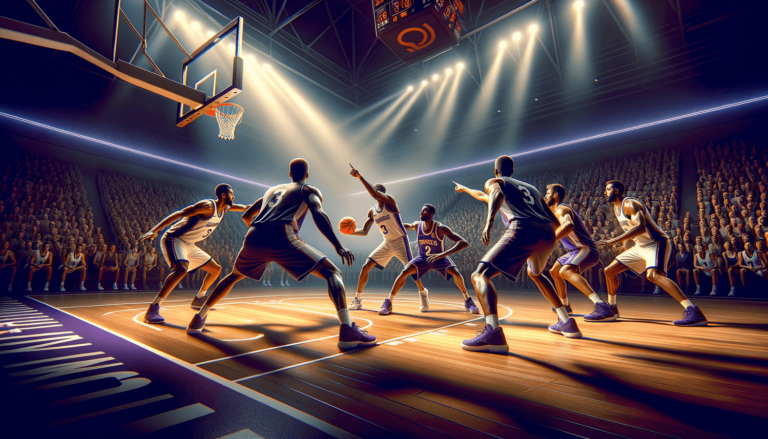
Welcome to the fascinating world of basketball defense strategies, where today we’re diving into the nitty-gritty of the 3-2 Zone Defense! Often considered the go-to choice for disrupting opponent’s offensive rhythm and orchestrating an impenetrable fortress on the court, the 3-2 Zone Defense is a top-notch tool in your squad’s defensive arsenal. Buckle up, dear readers, as we break down this mighty defense system, explore its tactical intricacies, and uncover how your team can master the art of the 3-2 Zone Defense to keep that scoreboard ticking in your favor!
What’s a 3-2 Zone Defense in Basketball?
The 3-2 Zone Defense in basketball is a defensive strategy where players are assigned to specific areas or “zones” on the court, rather than guarding individual opponents. In this setup, three players position themselves near the perimeter, while two players settle closer to the basket, forming a 3-2 formation. This defense aims to disrupt the opposing team’s outside shooting, clog passing lanes, and limit penetration into the paint, effectively dictating the flow of the game and forcing the offense into low percentage shots.
Discovering the Chessboard of Basketball: The 3-2 Zone Defense
It’s time to delve deep into the pages of basketball tactics as we explore one of the most effective and exciting defensive formations in the game – the 345-2 Zone Defense! As you embark on this strategic journey, you’ll gain an understanding of how this defense works, the key roles and responsibilities of each player, and how you can sharpen your team’s prowess to dominate on the court. So, let the games begin!
Dissecting the Formation: How Does It Work?
In the 3-2 Zone Defense, players are assigned specific zones or regions on the court rather than marking individual opponents. At first glance, they’ll arrange themselves in a 3-2 formation: three players positioned close to the three-point line, and two others stationed nearer to the basket.
Frontline Soldiers: The Perimeter Trio
The three players on the frontline are responsible for contesting outside shots and impeding opposing players from executing their offenses. The central player in the frontline, typically a guard, occupies the high post region while the two remaining players, usually guards or forwards, set up on each wing. This configuration aims to force opponents into taking tough, contested shots from the perimeter, thus lowering their shooting percentage.
Backline Reinforcements: The Paint Protectors
The two backline players, typically forwards or the center, guard the paint and the low post area. They strive to disrupt passes near the basket, stifle drives into the paint, and secure rebounds off missed shots. As a united front, they create a barrier that limits scoring opportunities for the opposing team in the paint, compelling them to settle for low percentage shots.
3-2 Zone Defense: Deciphering Player Roles and Responsibilities
Mastering the 3-2 Zone Defense demands seamless coordination and quick decision-making from each player. By understanding their respective roles and responsibilities in the system, players can function seamlessly as a cohesive unit, snuffing out opponents’ attacks on the hardwood flooring. Let’s dive into the specific roles each player is tasked with.
Point Guard: The On-Court Commander
Within the 3-2 Zone Defense, the point guard assumes the most crucial role. Stationed in the center of the frontline, they excel at reading the offensive game, reacting to ball movements, and communicating with teammates. The point guard needs to be agile, vocal, and possess a razor-sharp basketball IQ, as they must make split-second decisions to rotate, sag, or contest shots based on opponents’ actions.
Wing Guards/Forwards: The Fast and Furious Defenders
The two wing players diligently patrol the flanks, contesting opposing players who attempt to shoot from the perimeter or drive into the paint. Equipped with quick feet and good lateral mobility, these players must possess the ability to closeout perimeter shooters and disrupt passing lanes. Also, they play a vital role in securing rebounds and igniting fastbreak offenses for their team.
Post Players: The Twin Towers of the Zone Defense
Commanding the paint, the two post players bear the responsibility of fortifying their team’s defensive fortress. They are primarily tasked with clogging the interior lanes to avert players from driving to the basket. Additionally, their imposing presence seeks to disrupt opposing team’s low post plays and offensive rebounds. With their shot-blocking prowess and tenacity to crash the boards, the post players are indispensable to the success of the 3-2 Zone Defense.
Countering the Opponents: Adapting to Offensive Threats
Deploying the 3-2 Zone Defense effectively hinges on a team’s collective adaptability to different offensive threats. By anticipating opponents’ moves and adjusting swiftly, teams can dismantle offensive plays and orchestrate game-changing defensive stops. In this section, we’ll analyze the various tactics and strategies to counter common offensive strategies.
Neutralizing Sharpshooting Teams
When facing opponents with a penchant for draining outside shots, the 3-2 Zone Defense can be modified to extend pressure on the perimeter without jeopardizing interior defense. Players can adjust by extending the wings higher up the court, thus denying open shots for sharpshooters. While applying this adjustment, the point guard and backline players must also be ready to rotate and recover quickly to maintain balance and defensive integrity.
Foiling Relentless Drives to the Basket
Offensive teams that favor slashing to the hoop can be dealt with by tightening the 3-2 Zone Defense towards the interior. This compels players to compress the zone by forming a barrier around the restricted area, relinquishing some perimeter space in return. The key for success here lies in quick rotations and timely closeouts to prevent ball penetration inside the paint, forcing opponents into contested mid-range shots or awkward floaters.
Thwarting Teams with Prolific Post Scorers
In the event of facing an offensive juggernaut that relies on dominant post play, the 3-2 Zone Defense demands extra vigilance and swift reactions from post defenders. Double-teaming the post scorer, fronting the post to deny a clear entry pass, and swift rotations to cover weak-side help defense are crucial aspects teams must execute to stymie prolific post scorers.
Transforming Defense into Offense: Exploiting Defensive Advantages
Knowing how to turn a staunch defense into potent offense can provide the perfect springboard to gain momentum and seize the upper hand during a grueling basketball showdown. The 3-2 Zone Defense offers ample opportunities for teams to turn stops into swift counter-attacks, leaving opponents gasping for air. Let’s explore these offensive game-changers.
Igniting the Fastbreak: The Art of Transition Offense
Having snuffed out an opponent’s offensive thrust, a well-disciplined 3-2 Zone Defense can swiftly morph into a blistering fastbreak. Players should capitalize on turnovers, steals, and defensive rebounds, turning those into lightning-quick transition plays. This change of pace can take their adversaries by surprise, enabling easy scoring chances before the opposition can set up their defense.
Fly with the Wings: Unleashing the Power of Athleticism
Deploying athletic guards and forwards in the 3-2 Zone Defense can bolster your team’s ability to propel into fastbreak offensives. These nimble and explosive athletes can race down the court for spectacular dunks, layups, or open shots, making it virtually impossible for opponents to keep pace. Coupled with astute decision-making and consistent execution, your team can transform any opportunistic defensive stop into a highlight-reel play.
From Defense to Dictating Play: Forcing an Unraveled Offense
The well-executed 3-2 Zone Defense can compel opposing teams into taking low percentage shots, which often result in missed attempts and long rebounds. Seizing these opportunities to press on the counter-offensive can upset the opposition’s rhythm and keep them permanently off-balance. Amidst defensive stops, turnovers, and high-octane fastbreaks, your team can exert a stranglehold on the game and dictate play on both ends of the court.
As you explore and understand the intricacies of the 3-2 Zone Defense, it’s essential to practice, adapt, and experiment with this powerful strategy on the path to basketball supremacy. Remember, practice makes perfect, and by refining your team’s execution and communication, you’ll instill an impenetrable defensive fortress that will leave opponents scratching their heads and reeling in despair.
Pitfalls and Weaknesses: How to Avoid Common Mistakes
Every defensive system has its flaws, and the 3-2 Zone Defense is no exception. While it can be a potent weapon in a team’s arsenal, it can also be exploited if not executed properly. It’s crucial to understand the potential weaknesses and pitfalls of the 3-2 Zone Defense to avoid them and persist in maintaining an effective defensive stronghold. Let’s examine the common missteps and means to counter them.
Rebounding Woes: Securing the Boards
In a zone defense, players are less accountable for boxing out their individual matchups, which can lead to increased offensive rebounding opportunities for the opposing team. To counter this, players must be disciplined in securing their designated areas and actively pursue rebounds as a collective unit. Communication, positioning, and fervor for controlling the boards are critical factors that contribute to successful rebounding within a zone defense.
Defensive Rotations: The Achilles’ Heel
One of the most common pitfalls in the 3-2 Zone Defense is slow rotation and recovery, which can lead to uncovered areas on the court and open shots for opponents. Ensuring fluid rotations and swift adjustments can reduce the susceptibility of the zone defense to these breakdowns. Vigilant communication, court awareness, and a keen understanding of teammates’ positioning is imperative to overcome potential mismatches and weaknesses in the 3-2 Zone Defense.
Perimeter Vulnerability: Dealing with the Three-ball
At times, the 3-2 Zone Defense can leave teams vulnerable to deep shooting threats, especially if the opposition is loaded with talented three-point shooters. To neutralize this danger, defenders may have to extend further out to the perimeter, putting pressure on shooters and forcing them to put the ball on the floor. Additionally, any gaps in the zone should be sealed through rapid rotations, ensuring that high-percentage, open shots are kept to a minimum.
Comparing the 3-2 Zone Defense to Other Defenses
Defensive systems in basketball are as numerous as the strategies that guide them. To better comprehend the 3-2 Zone Defense’s overall effectiveness, it is helpful to compare it with other defenses, such as the 2-3 Zone Defense and man-to-man defense. This will enable you to determine the right situations to employ the 3-2 Zone Defense as your default strategy or an alternative game plan.
3-2 Zone Defense vs. 2-3 Zone Defense
While both the 3-2 and 2-3 Zone Defenses are based on zonal marking principles, they have distinct advantages and disadvantages against specific offensive styles. The positioning of players in the 3-2 Zone Defense prioritizes perimeter coverage, whereas the 2-3 Zone Defense focuses on protecting the paint with three low-post defenders. Consequently, the 3-2 Zone Defense is highly effective against perimeter-oriented teams, while the 2-3 Zone Defense excels at shutting down interior offenses.
3-2 Zone Defense vs. Man-to-Man Defense
The man-to-man defense is an entirely different breed of defense, which, as the name suggests, involves defenders closely marking individual opponents. While man-to-man defense allows for better accountability and individual matchups, it leaves teams susceptible to mismatches, pick-and-roll plays, and isolation attacks. In contrast, the 3-2 Zone Defense disrupts the flow of the opposing offense by denying easy penetrating drives and contesting outside shots, forcing them into less effective offensive options.
As this comprehensive analysis of the 3-2 Zone Defense draws to a close, it’s important to reflect on how this strategic approach to basketball defense can elevate your team’s performance on the court, both offensively and defensively. By understanding the intricate inner workings of the 3-2 Zone Defense, developing adaptability to tackle numerous offensive threats, and acknowledging its limitations and weaknesses, you will be well-equipped to nurture a top-notch defensive unit that leaves competitors dumbfounded and dreading every possession against your team.
Frequently Asked Questions: Mastering the 3-2 Zone Defense
Ready for more? Satisfy your thirst for knowledge as we answer frequently asked questions related to the 3-2 Zone Defense, providing expert insights and further guidance in your pursuit of basketball greatness.
1. When should a team opt for the 3-2 Zone Defense?
A team might consider using the 3-2 Zone Defense when facing opponents with strong perimeter shooting abilities, as the formation places more focus on contesting outside shots and disrupting passing lanes. It’s also effective for conserving player energy or hiding weaker man-to-man defenders within a team-centric defensive system.
2. What are the key strengths of the 3-2 Zone Defense?
The main strengths of the 3-2 Zone Defense are its ability to stifle opponents’ outside shooting, obstruct passing lanes, limit penetration into the paint, and force teams to settle for low percentage shots, effectively dictating the flow of the game and creating fastbreak opportunities.
3. Can the 3-2 Zone Defense work against a dominant post scorer?
While the 3-2 Zone Defense is not inherently designed to shut down dominant post scorers, it can be adapted to counter them through swift rotations, fronting the post player, and employing timely double teams to deny easy scoring opportunities inside.
4. Is the 3-2 Zone Defense suitable for all player types?
The 3-2 Zone Defense can accommodate various player types, but it’s most effective when executed by agile guards and forwards who possess quick lateral mobility and good anticipation skills, as well as shot-blocking and rebounding post players who patrol the paint.
5. How does the 3-2 Zone Defense compare to the 2-3 Zone Defense?
While both defenses are zone-based, the 3-2 Zone Defense prioritizes perimeter coverage with three high-post defenders, whereas the 2-3 Zone Defense emphasizes protecting the paint with three low-post defenders. The choice between them depends on the specific offensive threats posed by the opposing team.
6. Can the 3-2 Zone Defense be exploited, and how?
Yes, the 3-2 Zone Defense is vulnerable in certain scenarios. Teams can exploit it by hitting long rebounds on failed 3-point attempts or finding holes in the defense by rapidly moving the ball and exploiting slow rotations. Good offensive rebounding and exploiting gaps in the wing areas can also undermine the effectiveness of the 3-2 Zone Defense.
7. Is the 3-2 Zone Defense suitable for youth or inexperienced teams?
Although the 3-2 Zone Defense demands some experience in terms of understanding roles and rotations, it’s still a viable strategy for youth and inexperienced teams, as it removes individual defensive responsibilities and provides players with a chance to develop defensive skills and instincts within a structured system.
8. How can the 3-2 Zone Defense be adjusted to guard against better-shooting teams?
When facing teams with proficient outside shooters, the 3-2 Zone Defense can be adjusted by extending the wings higher up the court and increasing pressure on the perimeter, while other defenders must be prepared to rotate and recover quickly to maintain the defensive balance.
9. How important is communication in the 3-2 Zone Defense?
Communication is crucial for an effective 3-2 Zone Defense. Players must stay vocal and alert, constantly relaying information about opponents’ movements, any potential mismatches, and necessary rotations, ensuring seamless execution of their defensive responsibilities.
10. What are the key adjustments teams can make within the 3-2 Zone Defense during a game?
Several in-game adjustments can be made within the 3-2 Zone Defense, including extending pressure on the perimeter, tightening protection around the paint, compressing the zone to counter drives, and altering defensive rotations to neutralize specific offensive threats.
11. How should players practice to master the 3-2 Zone Defense?
Players can practice mastering the 3-2 Zone Defense by participating in regular team drills that focus on understanding individual roles, defensive rotations, rebounding responsibilities, communication, and anticipating various offensive threats they may encounter during a game.
12. How can teams adapt the 3-2 Zone Defense to their specific strengths and weaknesses?
Teams can adjust the 3-2 Zone Defense to capitalize on their specific strengths, such as emphasizing shot-blocking prowess, athletic perimeter defenders, or even extending defensive pressure. Conversely, they can cloak individual weaknesses by strategically placing weaker defenders within the zone, ensuring that the team operates as a cohesive defensive unit.
13. How can teams transition from the 3-2 Zone Defense into an effective offense?
Teams can rapidly transform the 3-2 Zone Defense into a potent offense by capitalizing on turnovers, steals, and defensive rebounds, turning them into swift counterattacks or fastbreak opportunities. Quick decision-making and alertness are crucial in carrying out swift offensive transitions that leave opponents reeling.
Featured Posts
- No pillar pages found.





